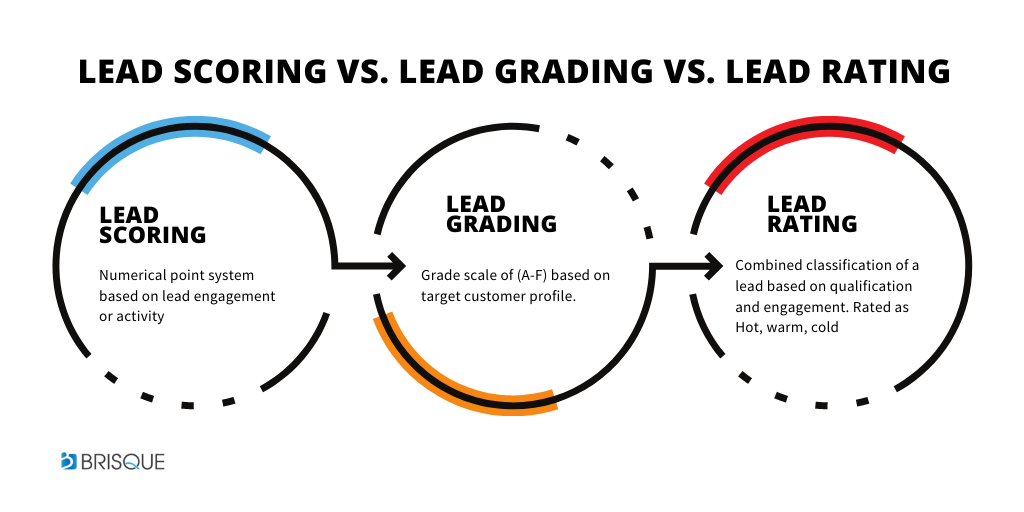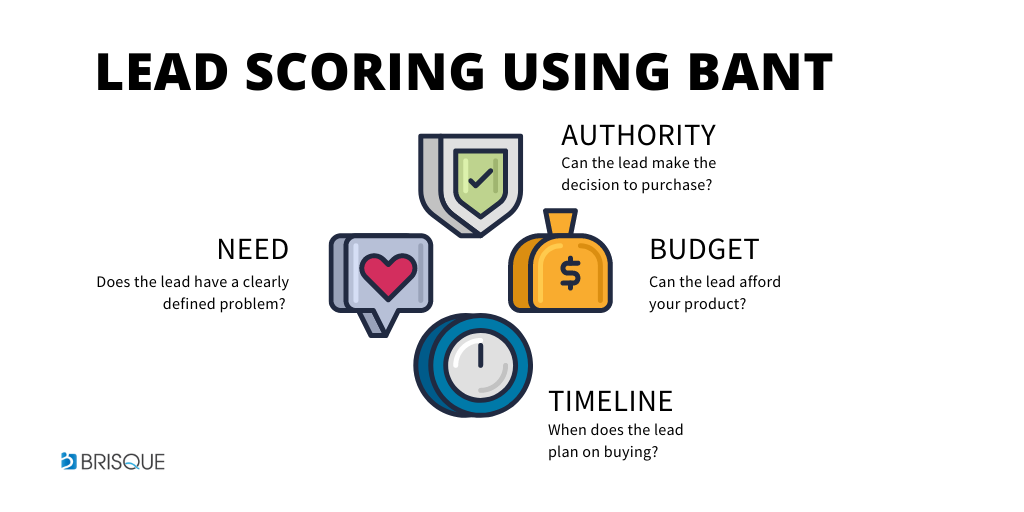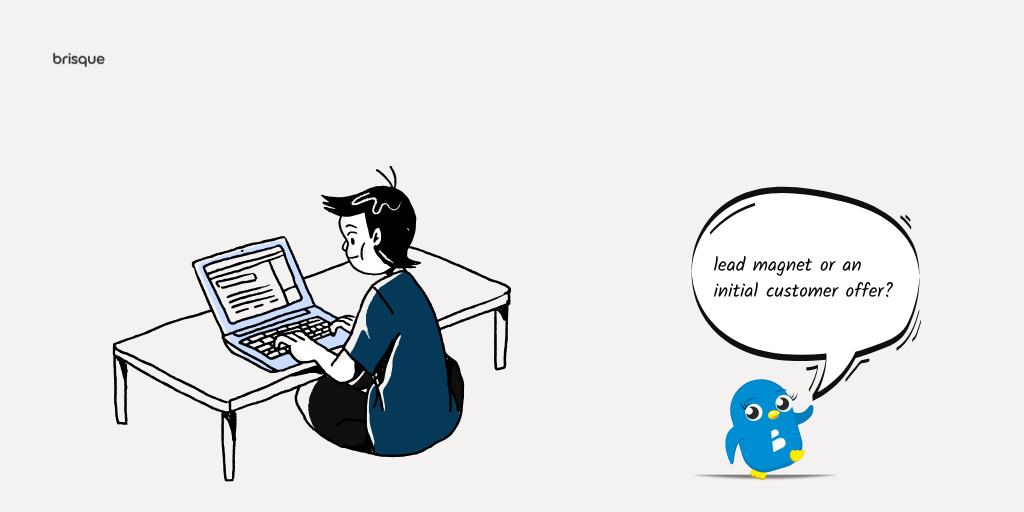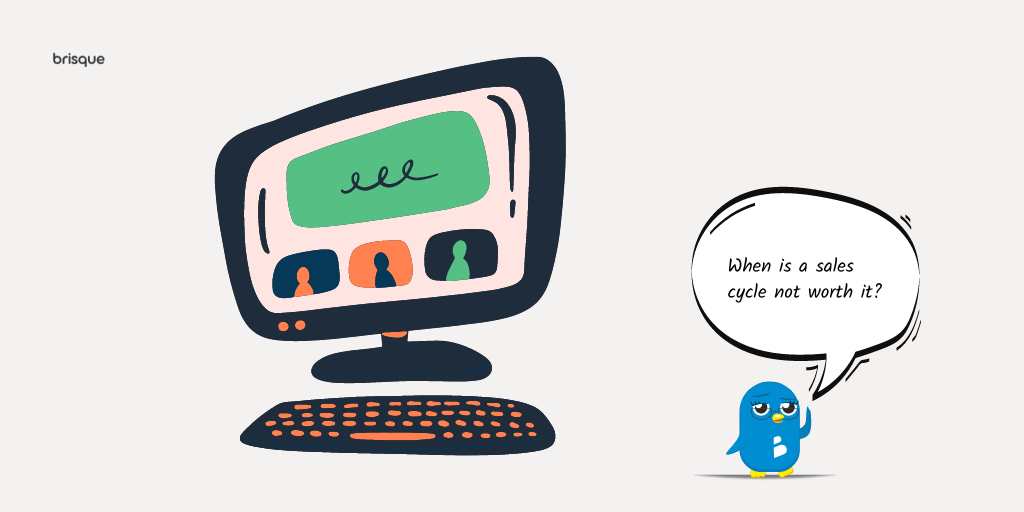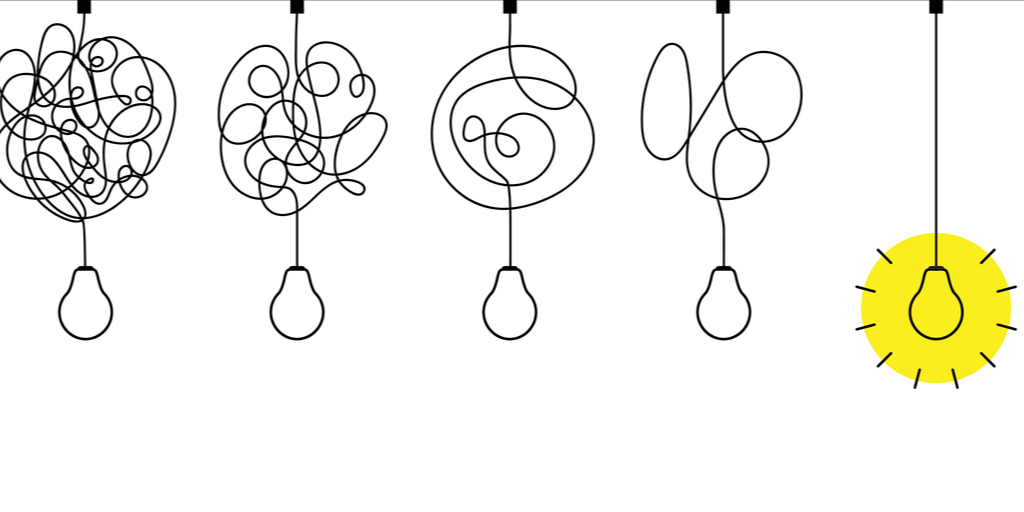Summary
In this guide, I’ll walk you through the steps and examples of how to create a lead grading and lead scoring model or a lead rating system.
Want to save this guide?

It’s clear that not all leads are the same. When you have many leads, you need to evaluate and determine if it’s a great opportunity or not. Ideally, you also want to create a lead scoring and grading system that can help you prioritize and qualify your leads.
Luckily, many lead scoring systems or software solutions can help you automate the process for your lead scoring and lead grading. However, for easy understanding, in my lead scoring example, I’ll run through the manual process of setting up the lead scores and grades.
Before we get into the specifics of setting up your lead grading and lead scoring framework, let’s first look at some fundamentals of lead scoring and grading.
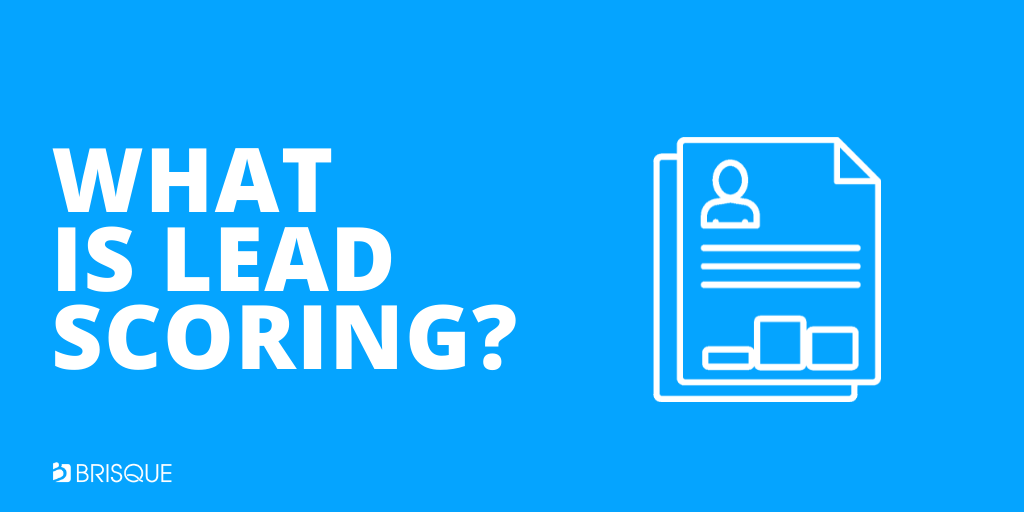
What is Lead Scoring?
Lead scoring is the process of assigning a numerical score or number to a lead based on lead activity, lead type, or a preset qualification criterion. Lead scoring can also happen automatically within lead scoring systems that have created their own lead scoring rules to score leads automatically.
Why is Lead Scoring Important?
In a perfect world, every lead will be ready to buy with a credit card in hand. However, the reality is that you’ll have leads at different stages of the buyer’s journey. Lead scoring and qualification is an effective way to help you sort out leads.
Here are the reasons why a lead scoring process is beneficial:
1. Lead Scoring Helps You Prioritize
A lead scoring process helps you prioritize the leads to follow up with. For example, if you have 100 leads, you can use your lead score to determine which leads to follow up with first, starting with the leads with the highest lead score.
2. Lead Scoring Improves Lead Nurturing
A lead scoring model helps you nurture your leads with contextual, relevant marketing information based on their lead score or level of engagement. For instance, leads with higher lead scores can get content geared towards closing a sale, while lower lead scores can receive educational content.
3. Lead Scoring Helps with Sales Forecasting
A lead score can be effective at helping to determine if your deals are likely to close or not, to help you with your sales forecasting process. Leads with higher lead scores tend to be more engaged and are likely to close faster.
4. Lead Scoring Helps with Qualifying and Disqualifying Leads
If you have a lead scoring process with lead qualification included, your lead score can quickly help you qualify or disqualify leads if they don’t meet your ideal customer profile.
When Should You Use Lead Scoring?
As mentioned above, use lead scoring whenever you have a sizeable number of leads and would like some intelligence on your leads.
Regardless of a lead’s stage in the buying cycle, not all leads are the same.
You’ll have some leads that are more engaged and are ready to take the plunge than others.
At times, you’ll have very active people with your lead nurturing activities, including clicking emails and downloading resources but don’t convert to ask for a sales call even though they are actively looking and in the market. The main benefit of lead scoring is to help you identify some of these opportunities so you can proactively reach out to those leads.
What’s The Difference Between Lead Grading, Lead Scoring, And Lead Rating?
It’s very easy to confuse lead grading, lead scoring, and rating because they are associated with qualifying, tracking lead engagement, and prioritizing leads.
Lead Grade vs. Lead Score vs. Lead Rating
The main difference between lead rating and lead score is, a lead grade focuses on lead qualification or if the lead meets your target customer profile. On the other hand, a lead score can combine qualification and lead activity to generate a score. You can also generate a lead score based on lead engagement only. A lead rating combines lead qualification or lead grading to create a rating.
A-F Lead Grading
Some of the common types of lead grades include a traditional classroom grade scale (A – F). Like a classroom situation, you can get very detailed with this by deciding to have A, B+, B, B-, C, C+, C-, etc. You can also choose to keep it standard using A, B, C, D, E, and F. More to come on this when I run through my lead grading example below.
Hot, Warm, Cold Lead Rating
You can also choose to rate your lead as hot, warm, or cold. A lead rating of hot, warm or cold,
refers to the lead activity and qualification criteria or if the lead meets your target customer profile.
Here’s an example, a lead is rated as “hot” because he met the lead qualification criteria based on his company size and job title. However, after a salesperson has a conversation with the lead, the salesperson determines that the lead is not ready to buy soon and therefore changes the lead grade from hot to warm.
Why you should use a lead rating system
A lead rating system helps you determine which leads your sales team needs to pay close attention to and which leads need to be nurtured by marketing. Generally, leads rated as hot will be sales pipeline deals that the sales team is actively working on. Nurture warm leads with content marketing initiatives. For leads marked as cold, the goal is to re-engage these leads or, at some point in time, remove them from the system if needed. Often leads marked as cold might also have inaccurate data.
How Do You Score a Lead?
A lead score given to a lead can be based solely on lead activity or engagement only, or it can be a mix of both lead activity and qualification.
Some lead scoring systems use predictive lead scoring that uses a machine-learning algorithm to score your leads based on lead activity automatically. There is often the option to also create a custom criterion for lead grading and lead scoring.
How Does Lead Scoring Work?
The easiest way to understand how lead scoring works is to look at a lead scoring model example, which is essentially the rules used to determine a score to give a lead. In this guide, we’ll run through a few examples.
What is a Lead Scoring Model?
A lead scoring model is a methodology or framework for scoring leads. It is the lead scoring formula or leads scoring rules used to give your lead a numerical value. Your lead scoring model will have to be customized to meet your current business lead qualification and lead activity criteria. Essentially, there isn’t a one-size-fits-all lead scoring model.
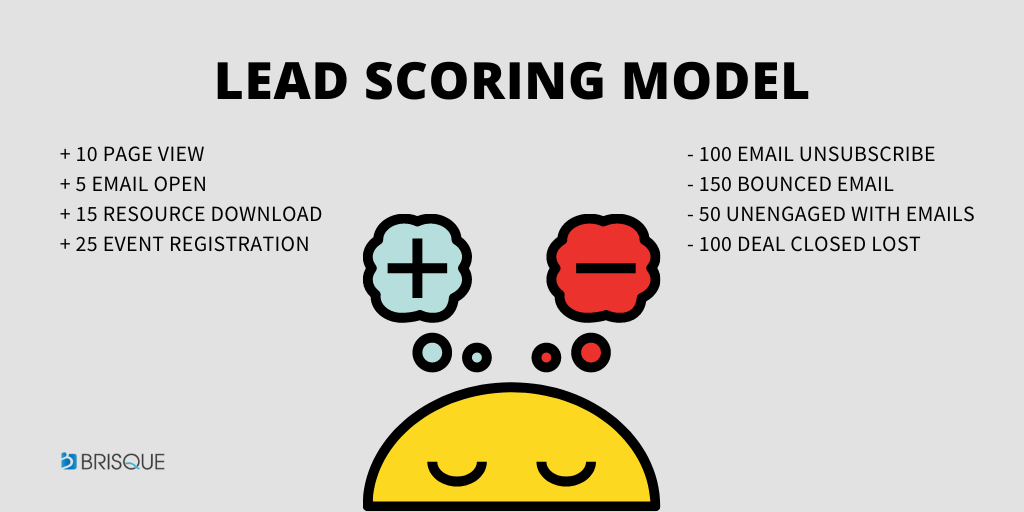
How Do You Create a Lead Scoring Model?
Creating a lead scoring model starts with thinking about all the potential buyers’ activities to become a lead. You must also think about the lead engagement activities you have in place after capturing lead information.
The idea is to gather as much intelligence on a lead as possible to determine if the lead should have a high or low score. There are quite a few marketing automation and lead scoring systems such as Salesforce Einstein, HubSpot, Microsoft Dynamics 365, Marketo, Eloqua, Pardot, Bitrix, and Zoho that have inbuilt lead scoring models to help get you started. You can also create a custom lead scoring model or formula using these systems.
Here are the basics of a lead scoring model:
A lead scoring model assigns a numerical value to a lead or contact in your system based on predetermined lead scoring rules. The lead scoring rules can be manually determined, or it can happen automatically using predictive lead scoring or an in-built lead scoring algorithm.
Types of lead scores
You can assign a lead two types of scores:
- A positive score
A positive score is assigned to a lead when the lead performs a desired action
- A negative score
A negative score is assigned to a lead when the lead performs an undesired action
I’ve listed some types of negative and positive actions to help you get started with creating your lead scoring template. These scoring rules are examples. As usual, you’ll need to tweak it to match your current business process and goals.
Lead Scoring Model Example: Positive and Negative Lead Scores
Positive lead score rules and sample lead scores
In this example, the lead engagement score threshold for review is 150. That means every time a lead scores 150 points, it’s supposed to trigger a follow-up activity either manually or automatically to proactively attempt to move the lead to the next level in the buying process.
| Activity type | Activity | Score |
| Web page visit | Blog page view | + 10 |
| Demo page view | + 75 | |
| Pricing page view | + 75 | |
| Contact page view | + 50 | |
| Product page view | + 35 | |
| Resource page view | + 25 | |
| Email marketing | Email open >1 | + 5 |
| Email click >1 | + 15 | |
| Purchasing intent | Demo form fill | + 150 |
| Pricing form fill | + 150 | |
| Contact form fill | + 100 | |
| Added items to cart | + 150 | |
| Resource download or subscription | Awareness stage content | + 25 |
| Consideration stage content | + 50 | |
| Decision stage content | + 75 | |
| Blog Subscription | + 25 | |
| In-person events & Webinars | Event registration or on-demand view | + 50 |
| Event attendance | + 25 | |
| Social media | Facebook clicks | + 5 |
| LinkedIn clicks | + 5 | |
| Twitter clicks | + 5 | |
| Instagram clicks | + 5 | |
| Facebook follow | + 15 | |
| LinkedIn follow | + 15 | |
| Twitter follow | + 15 | |
| Instagram follow | +15 |
Negative lead score rules and sample lead scores
| Activity type | Activity | Score | |
| Email marketing | Unsubscribe from all emails | – 150 | |
| Customer unsubscribes from customer communications email list | – 50 | ||
| Unengaged with last 5 emails | – 50 | ||
| Blog subscriber unsubscribes from the blog email list | – 150 | ||
| Bounced email* | – 150 | ||
| Social media | Facebook unfollow | – 15 | |
| LinkedIn unfollow | – 15 | ||
| Twitter unfollow | – 15 | ||
| Instagram unfollow | – 15 | ||
* A bounced email address should always trigger an addition to a cleaning list for removal or updating.
What Does a Lead Score Mean?
A lead score gauges the level of engagement. The most important aspect of interpreting a lead score is to have a set threshold. In my example above, I set a threshold of 150. That means every time that a lead meets the 150-score, it indicates that the lead has enough engagement activities to warrant a follow-up action. Additionally, deciding your threshold helps you with setting your lead scoring rules. In my case, since I know that I am trying to get to a 150-score threshold, things that indicate an intention to buy should be assigned a 150 value. Then, I work my way from there.
Here are things to analyze to help you with your point generation system:
- How many pages on average do leads visit before they complete a form or make a purchase?
For instance, if most leads complete a form or make a purchase after 5-page visits, that can help you with your lead scoring. You can decide to give each page visit a point of 30 (150/5) – and let that trigger a follow-up action if the lead doesn’t complete a form or make a purchase.
- What types of pages do my website visitors visit before completing a form?
Action: Categorize your page types into product pages, blogs, resource pages, etc.
- What website page visits demonstrate an interest in buying or getting more information? E.g., a pricing page visit will show an interest in knowing more about pricing options.
Lead Scoring for B2B vs. Lead Scoring for B2C
Lead scoring models may work similarly for B2B (Business-to-Business) and B2C (Business-to-Consumer) businesses. In both cases, you assign a numerical value based on their engagement activities. However, the core difference in lead scoring for B2B is that a sale may not happen directly online. As a result, in the B2C world, while a conversion might be considered a sale online, for B2B, a conversion could be a form fill indicating interest, e.g., a pricing information form fill.
How does lead scoring affect lead nurturing?
Lead nurturing is the process of gradually providing helpful content and engagement activities to a prospective customer to guide the person through the buyer’s journey to a sale. Lead scoring and lead nurturing work together to ensure that you use intelligence gained from customer interactions to determine what and when to send specific information to contacts. In my example above, whenever a lead meets the set lead threshold of 150, this can trigger a particular set of lead nurturing activities since it indicates an interest to know more.
When used effectively, lead scoring can provide useful added intelligence to lead nurturing activities to help with proactively closing more sales.
How to create a Lead Scoring Model Using BANT
BANT (Budget, Authority, Need, Timeline) is an industry-standard benchmark for qualifying leads or prospective customers. It’s a handy starting point for creating a way to qualify your leads. For example, to create a customized lead scoring model that considers lead engagement and lead qualification, you can use BANT.
Before diving into that, let’s first define the BANT criteria.
Budget
A budget simply refers to a prospective customer confirming that they have the budget to buy your product. Note that there isn’t often a way to confirm if this is true or not. You simply have to take the person’s word for it. In most cases, prospects are unlikely to lie about having a higher budget since it doesn’t serve their best interest.
Authority
Authority refers to if the lead has the authority to make the decision to make a purchase or not. Using authority to qualify an opportunity is quite tricky. The reason is that in business-to-business sales, there is sometimes a selection committee that determines which products to go with.
Usually, when companies have product selection committees or teams, there are often three groups of people who may be part of the sales process:
- Decision Maker: The final decision-maker who has to agree, or the deal may fall through
- Influencer: The influencer, whose recommendations are held in high regard and can influence a sale
- Researcher: The researcher puts together a list of possible solution vendors. Sometimes outside of the initial list, the person might not be involved in the final selection process.
In some cases, all these three roles fall under the purview of one person. The same person who does the research makes the final decision. On the other hand, sometimes the researcher could be the influencer who also has to convince upper management to make the final decision. There are many flavors of this equation. As a general rule of thumb, bigger businesses tend to have more separate roles, while smaller companies may have one person wearing many hats.
Need
A need is when a lead has a clearly defined problem. A potential customer having a need is very critical to a sale. If someone doesn’t have or see the need for a product, even with a budget, authority, or a timeline, your deal may drag on longer than it should. So again, the key here is to make your product a must-have instead of a nice to have.
Timeline
Timeline is when the prospective customer plans to make a purchase. Knowing a prospect’s timeline is essential in both your marketing and sales communication plan. For example, a prospect who is ready to buy in one year should have a different outreach plan from the one ready to buy in three months. On the other hand, a lead who doesn’t have a timeline in mind is very early on their sales journey, and you should nurture them as such.
Note that you should not include leads without timelines in your forecastable pipeline.
What’s the difference between your prospect’s timeline and an actual deal timeline?
A prospect’s timeline is when a prospect believes they’d like to purchase a product. In most cases, this timeline is an estimate at best. When calculating your deal timeline, you should look at when the person became an active opportunity. Meaning someone you feel met your opportunity qualification criteria to be included in your pipeline projections and be actively pursued by your sales team.
In essence, your deal timeline is your prospects said timeline plus or minus whenever the deal closes. Closing in this circumstance refers to both a close win deal and a close lost deal.
Do You Have to Have All Four of The BANT Criteria for A Lead to Be Qualified?
Budget and need are the basics for qualifying a lead
While each product and industry are different, for most products, having a need and budget is usually enough to qualify a lead.
What about timeline and authority?
Timeline and authority are essential but not as critical as the prospect needing your product and being able to afford it. Timeline is important because it helps you forecast and drive the conversation better. Authority, on the other hand, especially at the beginning of a sales process, is not as important. As I mentioned before, if there is a selection committee for the decision-making process, the other members will eventually be looped in. With that said, the level of authority that a prospect has to make a final call can affect the speed of a sales process.
How to Create a Custom Opportunity Grading Criteria Beyond BANT
Using the BANT opportunity qualification is an excellent start in the lead qualification process. I would, however, challenge you to create a custom lead scoring and grading system beyond the BANT qualification criteria and evaluate if you believe you can win a deal or not.
When creating your opportunity grading criteria, the critical thing to note is ensuring that the custom criteria you add are not due to anyone’s gut feeling.
What you want to do is to identify patterns that affect a sale’s close rate. Some things to look at include:
- For deals that close the fastest, what kind of needs do customers have?
- Which job titles do we have the most uncomplicated sales process with?
- What type of content offer tends to get us the most close-win deals?
Here’s a sample custom lead scoring model and grading beyond BANT
We’ll use a fictional project management solution that I’m calling “TIME” in this example. It is a business-to-business lead scoring example since the product is for businesses needing a project management solution.
The TIME Sales and Marketing Team has determined that they tend to win business with project managers that have a Project Management Professional (PMP) Certification than those that don’t. So, as a result, they’ve included that into their lead qualification criteria.
Now, TIME has modified its prospect qualification process to include the PMP certification. However, as we saw before, not every lead qualification criterion carries the same weight. As a result, you must rank your qualification criteria in order of importance.
Based on TIME’s previous history, they’ve decided to rank their lead qualification criteria this way:
- Problem
- Project Management Professional (PMP) Certification
- Budget Approved
According to the ranking, the team at TIME has determined that a prospective customer having a clearly defined problem is the most crucial element in their marketing and sales process.
Next is followed by the fact that the person has the PMP certification. Then, finally having a budget approved. Of course, each business will be different in how you rank your lead qualification. In most cases, however, a prospect defining a need or having a problem is the key element.
Creating Your Custom Lead Scoring Model with Lead Grading (Qualification)
To help you build a lead scoring model that incorporates your lead qualification criteria, you have to give the lead qualification areas a score. So, first, you have to determine your perfect score and then work your way from there. Since I used 150 in my previous example, I’ll change this up a bit and make the perfect score 100.
Lead Qualification Scores:
- Problem: 60
- PMP: 25
- Budget: 15
Why ranking your lead qualification matters
As you can tell from my scores, I gave certain lead qualification elements a higher score than others. That’s because they are more critical. So, by ranking your lead qualification, you can create a scoring process that reflects the level of importance.
For instance, having a budget is essential, but if you only have a budget, you won’t get the same score as someone who has an identified problem.
How to combine your lead score to create a lead grade
Finally, you can combine your lead scoring that’s based on your custom lead qualification to create a lead grading process that looks like this:
- Has a Problem and PMP and Budget = A (60 + 25+ 15 = 100)
- Has a Problem and PMP Only = B + (60 + 25 = 85)
- Has a Problem and Budget Only = B- (60 +15 = 75)
- Problem Only = C+ (60)
- Has PMP and Budget Only = C- (25 +15 = 40)
- PMP Only = D (25)
- Budget Only = E (15)
- Has no Problem and No PMP and No Budget = F (50-30-20 = 0)
This grading process results in the decision tree illustration shown below:
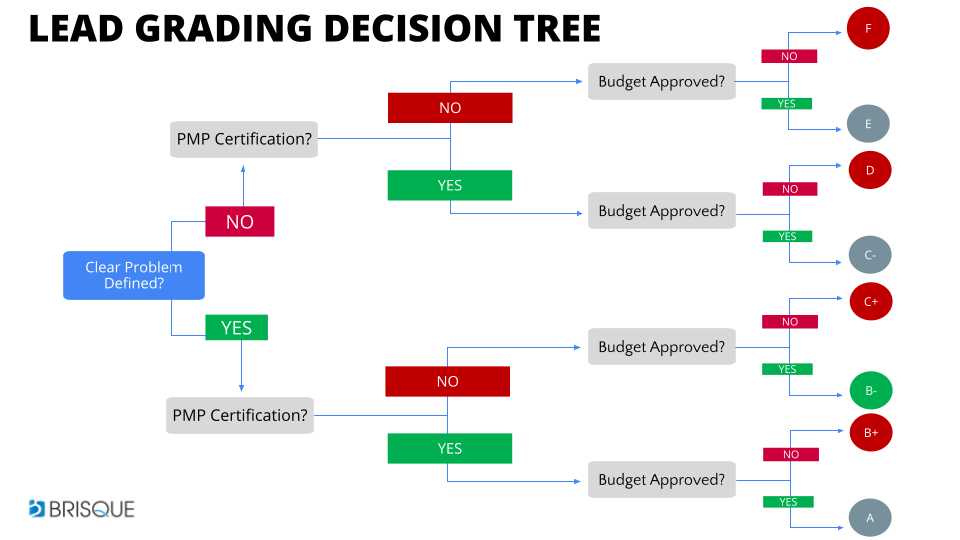
Lead Grading Decision Tree Example
Set this up in your lead scoring system
You can set up this type of lead scoring and grading process to run automatically in your lead scoring system, such as a Customer Relationship Management (CRM) or Marketing Automation System. Just follow the scoring rules listed here as a starting point to help you create your own.
Combining Lead Scoring, Lead Grading, and Lead Ranking
You can opt to use all three lead assessment factors of a score, a grade, and a rank. It’s straightforward to combine all the elements to create a very robust lead intelligence system. However, while it’s easy to automate lead scores and lead grades, you should manually determine the lead rating based on human intelligence rather than a system automation. Basically, a lead with a score of 100, and a grade of an A, could have a warm rating because the lead doesn’t seem very engaged throughout the sales process.
Here’s what that could look like based on the TIME example.
| Lead Score | Lead Grade | Lead Rating (based on the sales team information) |
| 100 | A | Warm |
| 85 | B+ | Hot |
| 75 | B- | Cold |
| 60 | C+ | Cold |
| 40 | C- | Warm |
| 25 | D | Cold |
| 15 | E | Cold |
This type of grading system shown above is easy to set up to run automatically in a Customer Relationship Management or Marketing Automation System that allows you to run automated workflows. If you don’t have an automation system, you can also just have this information handy and manually update each opportunity.
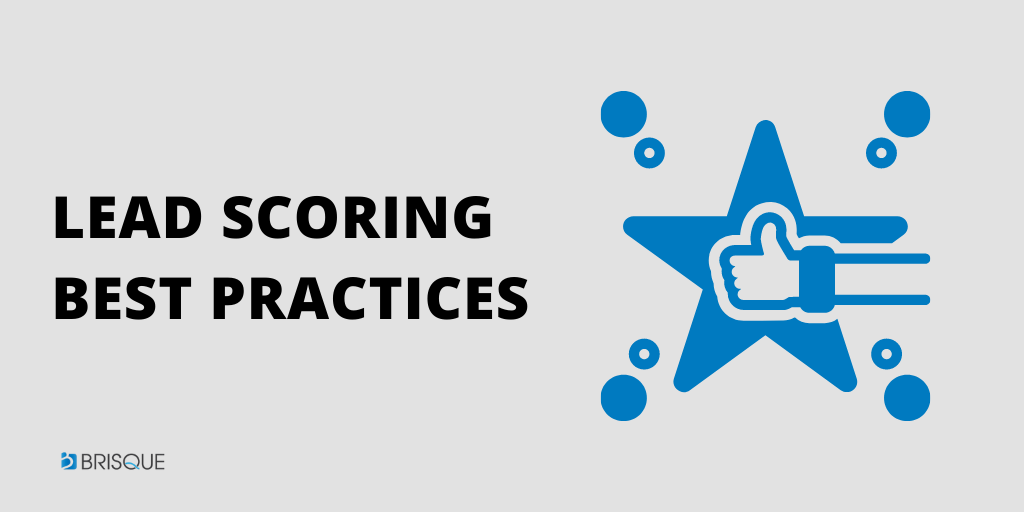
Best Practices for Lead Scoring
- Always have a lead score threshold in place. That is the ideal score that a lead should reach that demonstrates a certain level of interest.
- Automate your lead scoring process by setting up rules in a lead scoring system or use a system with predictive lead scoring.
- Setup a separate automation trigger that starts a specialized set of lead nurture activities after the lead reaches your set threshold.
- Ensure that you are adding and subtracting points based on the level of engagement that a lead demonstrates.
- Implement a manual review process as part of your automation. There might be engaged leads who don’t take the next step despite your best efforts with automation. The only way to ensure that you are proactive with your lead outreach is if your sales team is reaching out personally.
- No sales process for two businesses is the same. So always tweak lead scoring systems to match your unique sales process.
Final thoughts on lead scoring
A lead score, a lead grade, and an overall lead rating offer you a way to maximize your productivity when engaging with leads or prospects quickly.
At the end of the day, while we try our best to use automation systems to help us avoid manual work, it can’t replace human intelligence. A prospect is a person who is a bit more complex than a score or a grade.
- Always use additional information based on what’s happening in real life to decide how to engage with potential customers.
- Keep deals alive by using automated lead nurturing when a lead has a low engagement score. However, never make a prospective client feel unimportant because they don’t meet a specific lead score or lead grading criteria.
Want to save this guide for easy on-the-go access? Download it here »
I’d love to hear from you.
What kind of lead scoring and lead grading system are you currently using?
What’s worked, and what’s not worked so well? Share in the comments below.



